Welcome to the side of the world where we consume dried mango, Bicol express, and cassava cake by the dozen: this is gluten free food Philippines.
Don’t get it wrong. Being gluten-free in the Philippines isn’t always an easy task. However, with the right preparation, a good knowledge of gluten-free Filipino recipes, and the following guide to gluten free Philippines, there’s no need to cut short your travel plans.
Many gluten-intolerant visitors to the Philippines wrongly believe that they might have to live off plain rice or food packed in your suitcase before you depart your home country. However, that’s not the case.
You can still enjoy the popular and traditional cuisine in the Philippines in a safe and informed way, including mouthwatering meals, snacks and drinks like puto, kare-kare, taho, and laing.
If you’re searching for ‘gluten free food Philippines’ in the hope of getting some guidance on how and where to find gluten free foods in the Philippines, you’re in the correct place.
I’ve covered how to communicate your dietary needs in the Philippines, key foods and meals to avoid, big menu ‘red flags’, the main cross contamination issues, safe gluten free food and other essential tips for being gluten free in the Philippines.
I know that the unknown is a huge source of anxiety. So, as a gluten-intolerant digital nomad, I create gluten-free travel guides for every destination I visit. My goal is to help more people to travel widely, confidently, and safely.
What is the awareness of gluten free food and diets in the Philippines?
The concept of ‘gluten free’ hasn’t fully reached the Philippines. This is a country where vegetarianism and veganism are mostly viewed as fads. Therefore, gluten-free diets in the Philippines have been lumped in the same category (for the most part, anyway).
The knowledge around coeliac disease, wheat allergies, and intolerance is very limited in the general public. Chefs and servers may have a limited knowledge of gluten intolerance, or no clue at all.
The awareness of gluten intolerance is likely to greater in popular tourist areas such as Palawan, Boracay, Manila and Siargao. Restaurants visited by lots of tourists are also more knowledgable, such as hotel restaurants or restaurants based on streets where there is a high tourist footfall.
Planning your big escape? In short form, here are the booking resources I recommend and return to time and time again.
Book your hotel or hostel on Booking.com, Agoda or Hostelworld.
Try a homestay on Homestay.com.
Find the cheapest flights using Skyscanner.
Protect against accidents and emergencies with insurance from Staysure or SafetyWing.
Find a tour or experience on Get Your Guide.
Travel the world for free with TrustedHousesitters.
Gluten free food Philippines: How to say gluten free in the Philippines
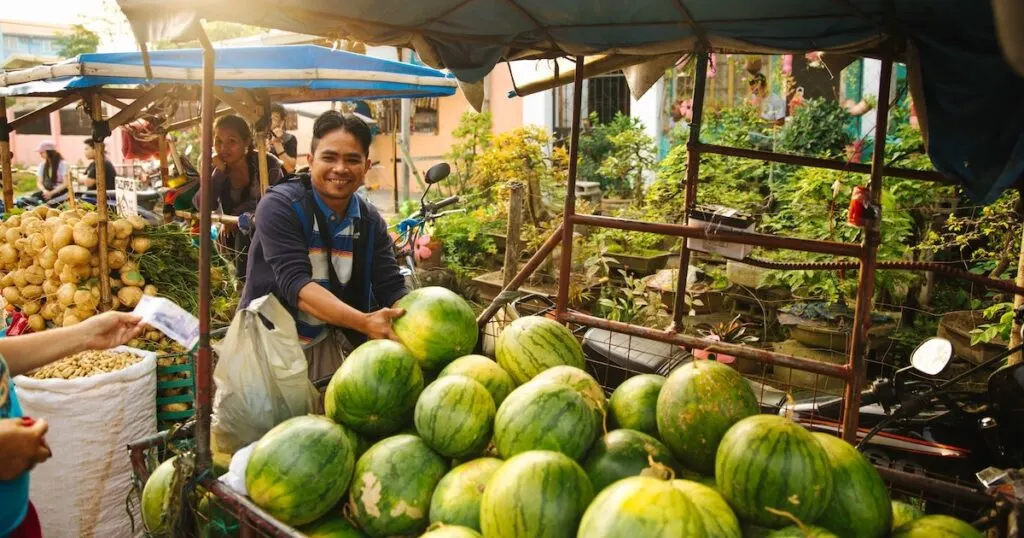
There are over 120 languages spoken in the Philippines. Tagalog and Cebuano are considered to be the primary native languages in the Philippines. They are spoken by over half of the population.
Out of the two main languages, Tagalog (also called ‘Filipino’ in its standardised form) is taught in the education system in the Philippines. Therefore, most Filipino people have a fluent, good, or basic understanding of Tagalog.
A basic or good understanding of English is also to be expected across the majority of the Philippines. However, if you visit remote or rural communities, it’s far less likely that the general public will speak or understand English than in touristic areas.
So, here comes the easy part.
‘Gluten’ is same in Tagalog as it is in English.
And, here comes the tricky part. Most Filipino people have no clue what ‘gluten’ actually means.
Therefore, to say gluten free in Tagalog, the best phrase to use is ‘walang gluten, trigo o harina’. This directly translates to ‘without gluten, wheat or flour’. Most Filipino people will register the meaning of ‘flour’ but not gluten.
If the server doesn’t understand what you’re saying, you can also try using the phrase, ‘allergic ako sa gluten at harina’, which means ‘I’m allergic to gluten and flour’.
Sometimes spelling out your intolerances is helpeful. In this case, to say ‘no wheat or flour, barley, rye or oats,’ use the phrase, ‘walang trigo o harina, rye, barley, o oat’.
Another word for rye is ‘senteno’. Another word for barley is ‘sebada’. Another word for oats is ‘obena’. You can try using all three.
The best way to cross any language barriers is by downloading the Google Translate app (available on iOS or Android). The app works offline, but its translations are more accurate when you have an internet connection. Using the app, you can specify specific food types, ask and answer questions, and fully confirm that your server has a full understanding of your dietary requirements.
Gluten free cards for the Philippines

Gluten free cards explain your intolerance or allergy in the native language of the country you’re visiting. They’re a valuable first-line defence because they take away some of the initial confusion when you first discuss your dietary requirements.
Don’t take a ‘yes’ as a definite sign that your server has understood. One thing I learnt in the Philippines is that if a Filipino has absolutely no clue what you’re saying, their knee-jerk response is to say yes and/or nod their head… yes, even when they’re presented with a very important gluten-free card.
They want you to be happy, but that doesn’t always mean that they understand what you’re saying.
The following free gluten free card made by Celiac Travel is written in Tagalog.
The card explains that the owner has coeliac disease and cannot eat food with gluten, including flour, rye, barley and oats, or any food made from it.
It also specifies that the visitor isn’t allowed to eat any batter made from flour like breaded pork chops, oatmeal, or croutons. It asks to be informed if the food contains soy sauce, teriyaki sauce, blue cheese, or beer.
It also lists what the owner can eat: things like meat, rice, corn, potatoes, eggs, vegetables, fruits, beans, nuts, oil, salt, sugar, non-processed cheese (not blue cheese), tofu, milk, and spices.
A note on the Filipino cuisine
Just because we can’t eat gluten doesn’t mean that we can’t delve into the significance of the Filipino cuisine. I think it’s important to understand, from a cultural point of view and to understand why ordering gluten-free food in the Philippines can sometimes be tricky.
The Philippines has over 100 different ethnolinguistic groups. Therefore, the cuisine varies significantly from island to island, from town to town, and from tribe to tribe.
Every island in the Philippines has a different set of naturally-available food materials. This, naturally, influences the recipes of that particular island or region too. For example, Bicolano cuisine uses a large amount of coconut milk and chili peppers because they are very abundant on the island of Bicol.
While the cuisine in the Philippines was originally Austronesian before colonial times, Filipino cuisine has since been influenced by Chinese, Spanish, and American settlers. This has affected everything from the modes of preparation, available imported ingredients, and recipes.

Another key trait of Filipino cuisine is that the dishes often combine sweet and sour flavours. I think this is what divides so many people; it’s very common to hear someone rave about how they love or hate the Filipino cuisine, and there’s usually little in between.
The cuisine uses a large amount of vinegar (mostly cane vinegar, palm vinegar, or coconut vinegar, which are handily gluten free). This is something you don’t see very often, especially in Asian cuisine.
What kind of foods are common in the Philippines?
Expect to see dishes containing naturally occurring ingredients in the Philippines, like mangoes, papayas, pineapples, calamansi (Philippine lime), guava, plantain, coconut (including coconut oil, milk, and cream), cassava, potato, carrot, yam, and sweet potato.
The most popular meats are pork, chicken, beef and fish, but in coastal island areas, seafood is rife. As you can tell, there’s a huge amount of naturally gluten-free food widely and naturally available in the Philippines.
On that note, Filipino people adore meat, especially pork, sausage and chicken. They don’t shy away from using most parts of the animal. It’s easy to find liver, oxtail, and whole pig… you name it. That’s not forgetting the famous street food, balut, which is a fertilised developing egg embryo, which is boiled, steamed, and eaten whole.
Because the cuisine in the Philippines is so experimental and varies so much from destination to destination, it’s more important than ever for gluten-free travellers to converse back and forth with the server and/or chef to make sure that their food is safe to eat.
Travel insurance is essential for any trip abroad. If you’re in an accident or experience an emergency, you need adequate cover. I recommend Staysure for single or multiple trips per year and SafetyWing for digital nomads.
Gluten free food Philippines: Food to avoid when you’re gluten free in the Philippines
Before we delve into exactly what you can eat in the Philippines, I’m going to lay out some ground rules for what you should definitely avoid. These are some of the most common contaminators that you may miss at first glance.
1. Soy sauce
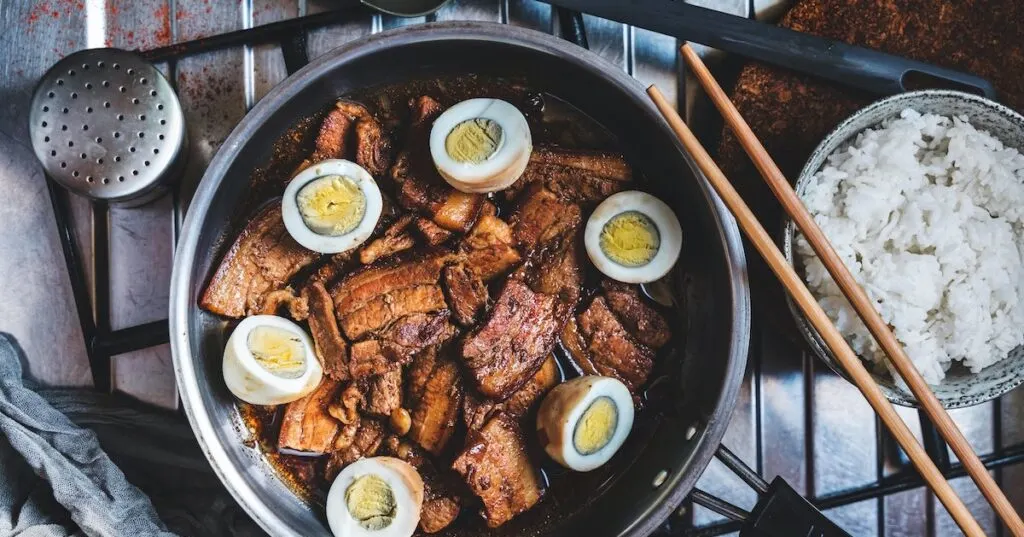
Adobo, one of the most popular meals in the Philippines, unfortunately uses a large amount of soy sauce or teriyaki sauce.
Soy sauce in Tagalog is ‘toyo’. Soy sauce contains wheat, as well as water, soy beans, salt, and fermenting agents. Therefore, it is not gluten free.
Many dishes in the Philippines which traditionally use soy sauce can be made without, but it’ll take a large amount of back and forth to be certain that it’s completely gluten free.
2. Teriyaki sauce
Teriyaki sauce is also popular in the Philippines. It is used to marinate chicken and other meats, and to season dishes like adobo. Unfortunately, it is not gluten free. Typical ingredients in teriyaki sauce are soy sauce (which contains water, salt, soybeans and wheat flour), rice vinegar (water, rice, and salt), water, brown sugar, corn starch, and sometimes ginger, onions, garlic powder, and tomato paste.
3. Oyster sauce
Most oyster sauce is gluten free, as it typically contains oyster extract, salt, sugar, and cornstarch. However, in the Philippines, not all of the brands are 100% gluten free; their recipes contain wheat. Therefore, dishes containing oyster sauce should be approached with caution, including beef stir fry and pork stir fry.
4. Deep-fried foods
I’m not talking about fried rice or egg, but deep-fried chicken, beef, or pork. If your food is fried, you should double check that it’s not going to be thrown in the deep fryer.
Deep fryers may be contaminated with gluten from other gluten-containing foods which have been cooked in the same fryer. In the Philippines, meats and other foods are often coated in wheat flour they are fried too, making them doubly off limits.
5. Blue cheese
Blue cheese is not gluten-free in the Philippines. The mold cultures are sometimes grown on rye or wheat bread. You should avoid all types of blue cheese.
6. Beer
As in any country, beer is off limits in the Philippines because it is usually brewed with water and barley malt (the offending ingredient), corn and hops. The most popular beer in the Philippines is San Miguel, which was established in San Manguel in Manila in 1890. It’s not gluten-free.
7. Dips
Dipping sauces are a common accompaniment for meals and snacks in the Philippines. They’re more of a red flag than a ‘strictly avoid’.
The most common dips are vinegar with onions, soy sauce and calamansi (the Philippines’ lime), fish paste, shrimp paste, crushed ginger and nilaga (fish sauce and calamansi). Soy sauce and nilaga are not gluten-free, so these dips should be avoided. Always make sure you’re clearly on exactly what dip you are served and its exact ingredients.
Gluten free food Philippines: Menu red flags
If you see the following words or phrases on a menu in the Philippines, they should be a big red flag, or at the very least, make you exercise some caution.
Adobo: Adobo is one of the most famous dishes in the Philippines, but the chicken or pork is marinated heavily in soy sauce and vinegar. Soy sauce is not gluten-free.
Banana cue: Banana cue is a popular snack. Skewered banana is dipped in brown sugar and deep-fried. The deep fryers may be contaminated with gluten if they are used to fry wheat-containing snacks too.
Canton: Wheat-containing egg noodles.
Chicharon (or tsitsaron): Chicharon is a popular snack. It is sold in supermarkets and street stalls, as well as served with tapas or an alcoholic drink. Sometimes it can be added to a meal as a topping. It consists of pork rinds deep-fried in oil and then dipped in coconut vinegar and soy sauce. Due to the possibility of cross-contamination in the fryer, I’d suggest avoiding chicharon.
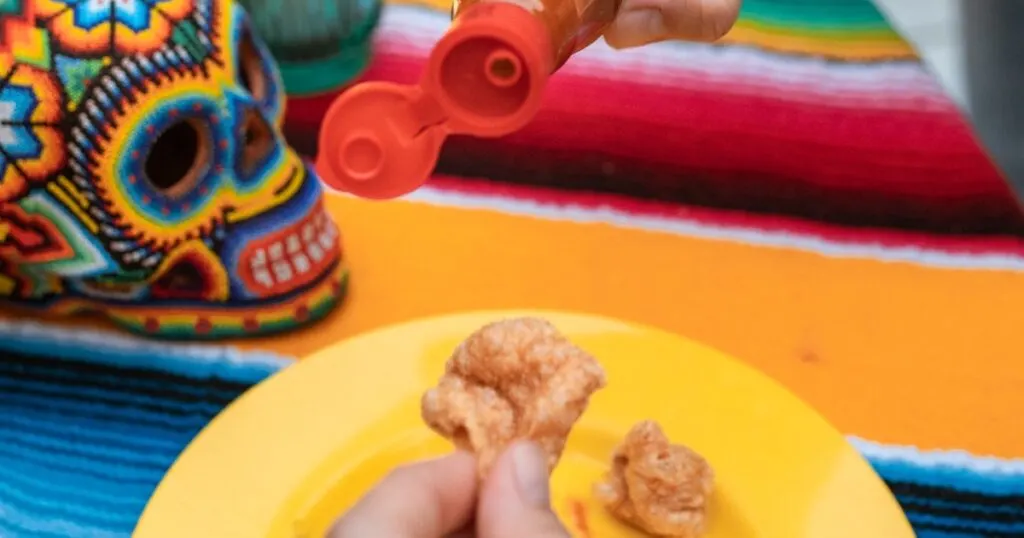
Empanadas: There are many versions of empanadas in the Philippines, including banana empanadas, but they are coated in wheat flour.
Ensaimada, pianono, biskotso/biscoco, sinipit: Popular Filipino wheat-containing pastries.
Goto: Goto is a rice porridge which contains beef tripe and chicharon. Chicharon could be contaminated with gluten. Therefore, goto should be avoided.
Humba: Humba is a famous pork dish in the south of the Philippines, originating from Visayas. Soy sauce, however, is a key ingredient.
Inihaw/inasal/sinugba: These grilled or pit-roasted pork or chicken sticks are served on bamboo skewers. However, they’re heavily seasoned in soy sauce and vinegar.
Ispageti: Ispageti is the Filipino version of spaghetti bolognese, which is made with banana ketchup and topped with a hot dog. It uses wheat spaghetti.
Longaniza: Longaniza is a sausage similar to chorizo. It should not be trusted because there’s a high risk of cross contamination with wheat-containing products during the production process.
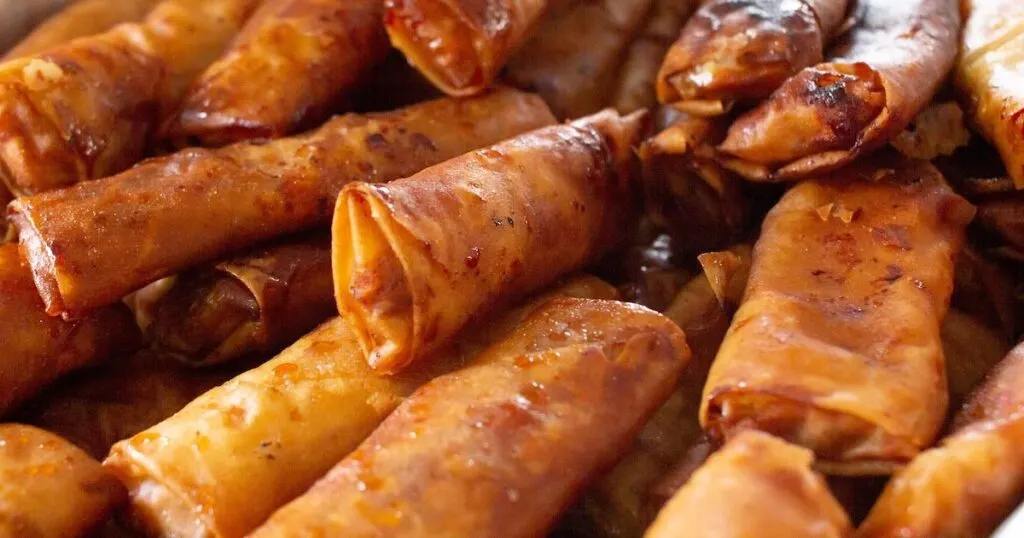
Lumpia: Lumpia are popular fresh or fried spring rolls wrapped in a roll containing wheat flour.
Mami: A noodle soup which uses wheat noodles.
Mechado: Braised beef cooked with soy and tomato sauce. Soy sauce is a key ingredient and impossible to substitute.
Miki: Yellow egg noodles which contain wheat and are usually square-shaped.
Misua or miswa: Wheat vermicelli noodles.
Odong: Yellow flour noodles.
Pia: Pastry or cake.
Pandesal or pan de sal: Salt bread commonly eaten for breakfast, made from wheat flour.
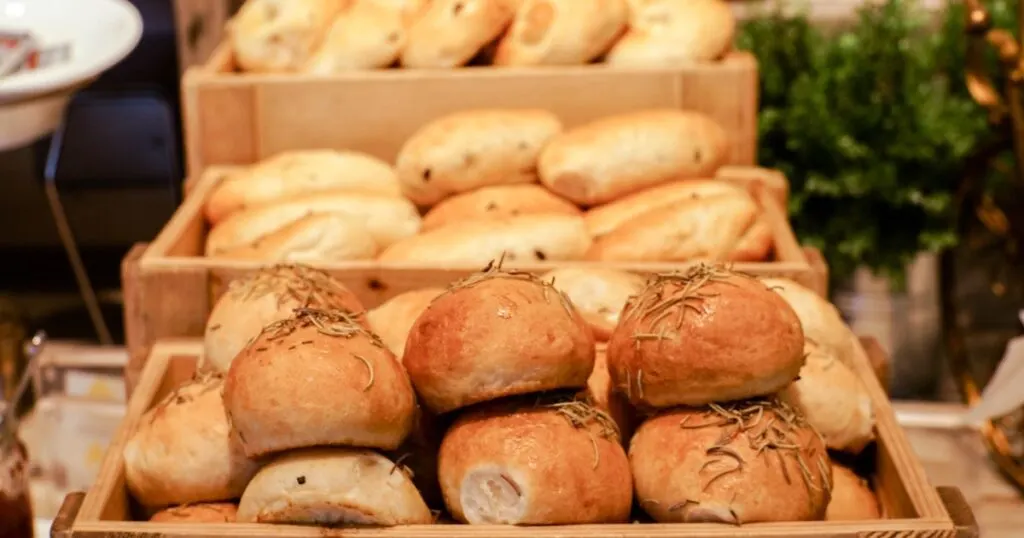
Pan de coco: A wheat-containing coconut bread roll.
Panaderia/monay/tinapay/: Wheat-containing breads, buns, or loaves.
Pancit: Pancit is the general term for noodle dishes in the Philippines. Any mention of pancit needs further investigation, as it could refer to any one of the following unsafe noodles types: canton (egg noodles), miki (square-shaped yellow egg noodles), misua or miswa (wheat vermicelli), or odong (yellow flour noodles). Safe noodle types are bihon (rice vermicelli) and sotanghon (mung bean vermicelli), as long as they aren’t cooked with soy sauce or other wheat-containing ingredients.
Torta: While torta is refers to a type of omelette in northern Tagalog-speaking parts of the Philippines, it means cake or pie in the southern Philippines.
Safe gluten free food Philippines
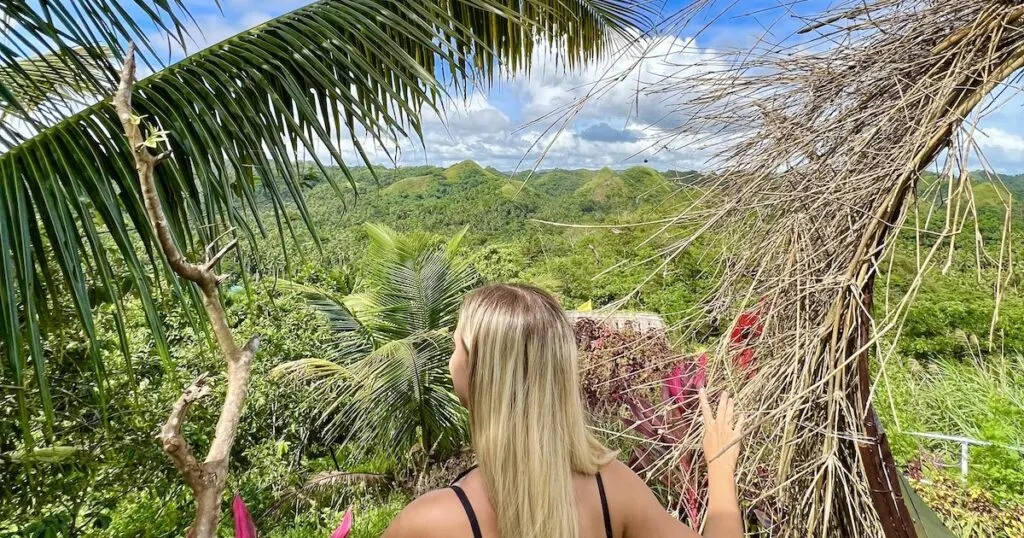
Before I finally delve into the wonderful gluten free foods of the Philippines, I want to make it clear that one of the most beautiful (and tricky) aspects of the cuisine in the Philippines is that it is very experimental.
Different regions, different families, and different chefs all have their own unique takes on traditional dishes.
While I can take care to tell you how the dish is traditionally made and warn you of possible contaminants, you should always take the initiative to double check with the server and the chef yourself.
I also cannot cover every single meal in the Philippines. The archipelago is huge, and the recipes are endless. Therefore, I have chosen to focus on the most common staple meals eaten across the whole archipelago and especially the types of food served in areas visited by tourists on a regular basis.
Gluten free meals in the Philippines
Rice-based meals will quickly become your go-to in the Philippines. Rice is the staple food on the archipelago. Most often, it is steamed and served with meat, fish, and vegetables. Therefore, your main role is to identify whether the accompaniment is gluten-free or not.
The main issue with rice dishes (especially popular dishes like adobo or fried rice) is that they contain soy sauce.
One way to get around this is to specifically ask for your dish to be made without soy sauce. This is more likely to be successful in a hotel restaurant or a higher-end English-speaking restaurant than it is in a busy local restaurant. It’s also easy when cooking fried rice, but harder if you’re cooking adobo, which highly depends upon soy sauce for its flavouring.
The following meals should be naturally gluten-free or highly adaptable:
Afritada: A common everyday meal in the Philippines consisting of chicken, beef, or pork braised in a tomato sauce with mixed vegetables such as bell pepper, carrot, and potato. It is served with plain white rice. There are also seafood variations. Seasonings include salt, black pepper, bay leaves, and fish sauce. You should ask the chef not to use fish sauce because this may or may not be gluten-free depending upon the brand.
Arroz caldo (chicken rice porridge): Arroz caldo is the Filipino variant of rice porridge. It contains glutinous rice, ginger, (traditionally) chicken, toasted garlic, spring onion, black pepper, and safflower (a herb). Usually, it is served with calamansi (Philippine lime) or fish sauce as condiments, and a hard-boiled egg. It is gluten free, as long as you ask for the dish without fish sauce.
Bicol Express (sinilihan): Bicol express is one of my favourite Filipino dishes. Originating from the island of Bicol, it is a stew containing pork (or chicken), coconut milk or cream, shrimp paste, chili peppers, onion, ginger, garlic, and stockfish (unsalted dried fish). It is traditionally gluten-free.
Champorado: Champorado quickly became my go-to breakfast in the Philippines. It is a dense chocolate rice porridge, also consumed as a snack. The typical ingredients are boiled sticky rice, cocoa powder, and either condensed milk or sugar for sweetness. Some champorado is made with coconut milk.
Inasal: Inasal is a popular chicken dish, which is marinated in calamansi, pepper, coconut vinegar, and anatta (natural food colouring). However, it is served with rice, calamansi, soy sauce, chicken oil, and palm vinegar. Omitting the soy sauce should make the dish gluten free.
Laing: Laing is a Filipino dish containing taro leaves and meat or seafood cooked in coconut milk, chili, lemongrass, ginger, garlic, and shrimp paste. It is gorgeous, and gluten-free.
Lechon: One of the most famous dishes in the Philippines is lechon, roasted pig stuffed with herbs. However, soy sauce is used in some preparations, so it may or may not be safe. You will need to ask whether soy sauce is used.
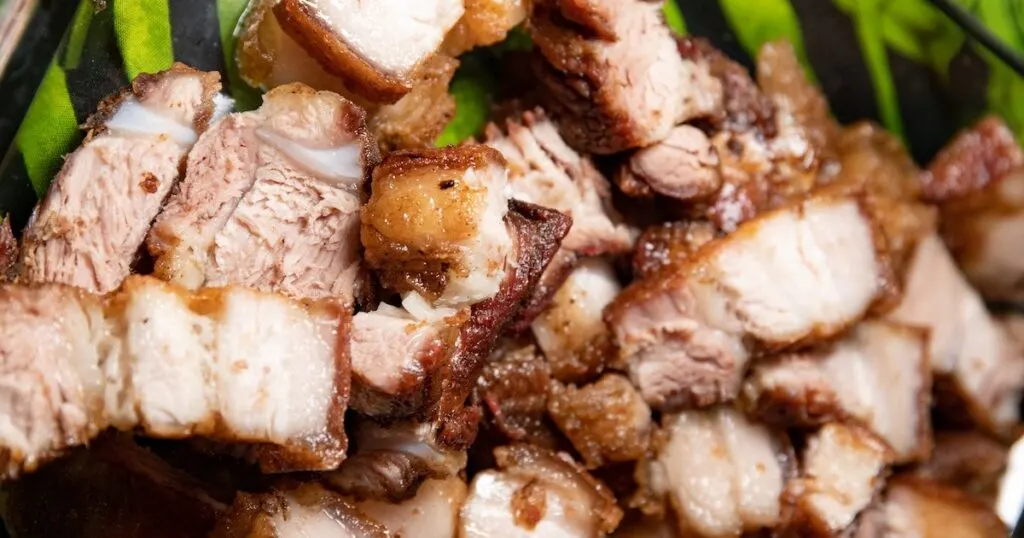
Lechon, one of the most famous pork preparations in the Philippines, should be gluten-free as long as soy sauce is not used.
Paella or Arroz la valenciana: This Philippine version of paella uses glutinous rice but otherwise follows the traditional Spanish paella methods. The paella is naturally gluten free, but you should avoid the chorizo variation, which is named longganisa in the Philippines. Manufacturers of chorizo may also make gluten-containing products, which heightens the risk of cross contamination. Spanish and bistro restaurants sell paella.
Puchero: Puchero is a Spanish stew, which in the Philippines, is made from beef chunks, plantain chunks, and other ingredients such as potatoes, sweet potatoes, bak choky, chickpeas, cabbage, and tomato sauce. It is naturally gluten-free, so long as it doesn’t contain chorizo.
Kaldereta: Beef kaldereta is a beef or goat stew made from tomato sauce and liver, with other ingredients such as potatoes, carrots, olives, bell peppers and chili pepper. It is naturally gluten-free.
Kare-kare: A popular stew originating in the Philippines which has a dense peanut sauce. It usually features vegetables like eggplant, cabbage and okra, and has a variety of meat, such as oxtail, beef tripe, pork hocks. It is naturally gluten-free. The sauce is made from roasted peanuts or peanut butter, onions, garlic, annatto and rice. Check no soy sauce is used.
Pinakbet (or pakbet or pinak bet): A Filipino dish popular in the northern Philippines. It consists of vegetables, fish, meat and bagoong (fermented fish or shrimp paste – which is gluten-free), and it is seasoned with ginger, onions and/or garlic. The dish doesn’t traditionally include soy sauce, but it’s worth double checking to make sure.
Sinigang: A soup/stew with the iconic Filipino sour-savoury flavour combination. The main ingredients in sinigang are meat, vegetables, tamarind, fish sauce, onions, siling mahaba and tomatoes. Fish sauce may or may not be gluten-free, depending on the brand, so as long as you confirm this (and the exact ingredients of that specific sinigang – there are many variations), you should be okay.
Sisig: Sisig is a popular Pork dish, made up of minced pork, onion, and chicken liver. Traditionally, sisig uses parts from the pig’s head, including the snout, ears, liver and belly. Calamansi, onion, and chillies are the main seasonings. However, soy sauce may also be used; ask for the chef to cook it without soy sauce.
Tocino: Tocino is cured pork belly, seasoned with Anise wine, annatto, water, sugar, and salt. Sometimes salitre and pineapple juice are also used. It’s usually served with garlic rice and/or sunny-side-up or scrambled egg. First, confirm that no soy sauce is used in the recipe. Then, eat.
Torta (tortang): In the southern Philippines, you should exercise caution with the word ‘torta’ because it can mean a cake or a pie. However, in the northern and Tagalog-speaking parts of the Philippines, torta is an omelette. There are many variations of torta, including an omelette grilled with whole eggplants. Most are naturally gluten-free, but tortang kalabasa and tortang kamote should be avoided because they are fried with flour and salt.
Gluten free snacks in the Philippines
Balut: If you are to try it, balut is a naturally gluten-free snack. Sold by street vendors, it is a boiled and steamed egg containing a fertilised duck embryo. The embryo is still intact.
Banana chips: Packages of banana chips are widely available across the Philippines, and of course, they are wonderfully gluten-free.
Bibingka: Sometimes bibingka can refer to any baked Filipino rice cake, including those made with cassava flour, glutinous rice, or plain flour (so, double check the ingredients). Normally, however, bibingka is a naturally gluten-free baked rice cake cooked in banana leaves in a terracotta oven, made up of glutinous rice fermented with palm wine, and then mixed with egg and milk. Common toppings are butter, sugar, cheese or grated coconut. Bibingka is traditionally a Christmas dessert or breakfast.
Biko: Biko is one of my favourite desserts and snacks in the world, especially when it’s in the biko à la mode version (biko paired with coconut ice cream). Biko is a dense dessert made up of sticky rice cooked in coconut milk and topped with brown sugar and coconut cream. Just thinking of it makes me start to salivate.
Crisps/potato chips: Potato and corn crisps are widely available in shops in the Philippines, so you should always be able to rely on a clearly-labelled packet of crisps if you don’t feel too adventurous.
Kutsinta: Very popular with Filipinos, kutsinta is a snack or breakfast made from rice flour, lye water, and anatto seeds topped with fresh coconut. It has a jelly-like consistency. Usually, it’s paired with puto (gluten-free rice cake) and a caramel spread.
Dried mango: The Philippines produces some of the best dried mango I’ve ever tasted in my life. Naturally, dried mango is gluten-free.
Mangga’t bagoong: Mangga’t bangoong is naturally gluten-free too. It is an unripe green mango cut into strips and paired with fermented shrimp (bagoong). Shrimp paste is gluten-free.
Gluten free desserts in the Philippines
Cassava cake (or cassava pudding, cassava pie, cassava bibingka): A classic Filipino cake made from grated cassava (or in the local language, kamoteng kahoy and balinghoy), coconut milk, egg, sugar, and milk.
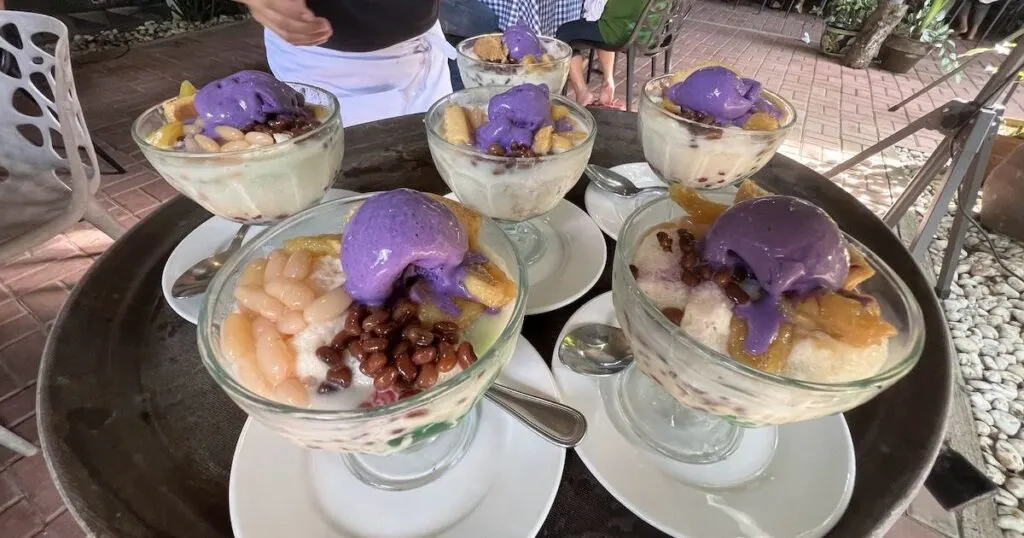
Halo-halo
Halo-halo: One of the Philippines’ most favourite desserts is halo-halo. Even with its many ingredients, which are interchangeable from recipe to recipe, it should be gluten-free. Halo-halo uses crushed ice and evaporated milk or coconut milk as a base. The most common toppings are ube jam, sweet kidney beans or garbanzo beans, coconut strips, sago, boiled taro or soft yam, flan (which contains eggs, condensed milk, whole milk and sugar), fruit slices, fruit jams, and other root crops. You can ask for details of the toppings if you’re uncertain.
Leche flan: Inspired by the Spanish flan, leche flan is made from sugar, eggs, and milk. Confirm that you are not buying flan cake or puto flan, which are sponge cake and cupcake versions of flan. Leche flan on its own is gluten free. Tocino del Cielo is also gluten-free; it’s the same as leche flan but contains more egg and sugar.
Puto: Puto is a steamed rice cake originating from the Philippines, which is made from fermented rice dough. They are usually white in colour, but they can also be green (pandan-flavoured) or purple (ube-flavoured). Be slightly wary, however, because puto is also a general umbrella term which refers to various steamed cakes, including cakes which are not made from rice flour.
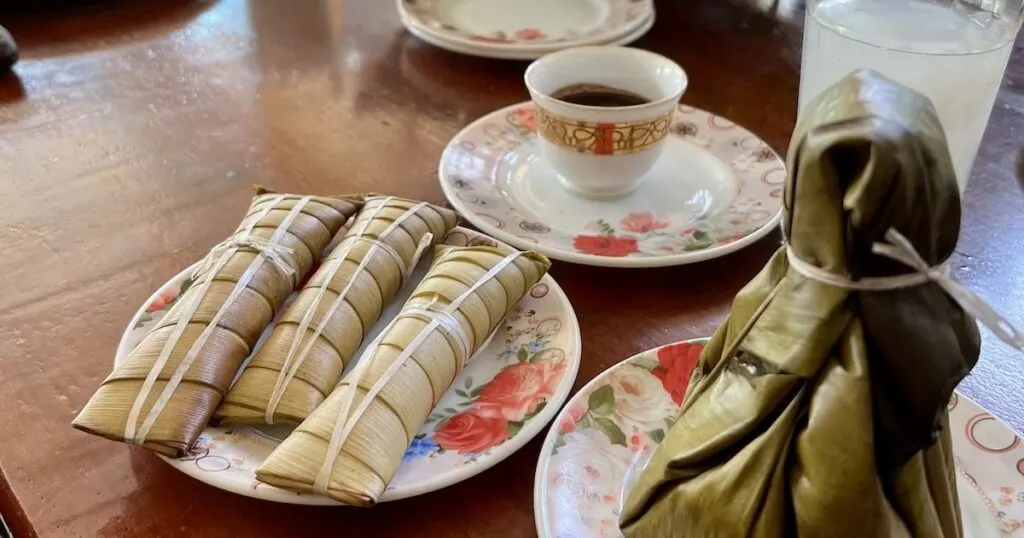
Rice cakes wrapped in taro and palm leaves.
Suman: Suman is a famous rice cake in the Philippines, wrapped in palm leaves and steamed. The glutinous rice is cooked in coconut milk, giving it a rich taste. It’s most often dipped in sugar or chocolate sauce.
Gluten free drinks in the Philippines
Smoothies and juices: Smoothies and juices are made fresh and sold all over the Philippines. They’re wonderfully gluten-free, as they use fresh or frozen fruit, ice cubes, and sometimes milk, coconut milk, yoghurt, or dairy ice cream. The best part about the stalls is that you can see the drink being made in front of you.
Basi: Basi is a local alcoholic spirit fermented from sugarcane. It’s gluten-free.
Buko juice (or coconut water): Coconut water in the Philippines is delicious, trust me. It’s also naturally gluten free. Most of the time, you’ll be handed a whole coconut with a straw. If you get lucky, they’ll chop the coconut in front of you. Buko juice sometimes has some sugar and coconut milk added, but this is the version served in a glass.
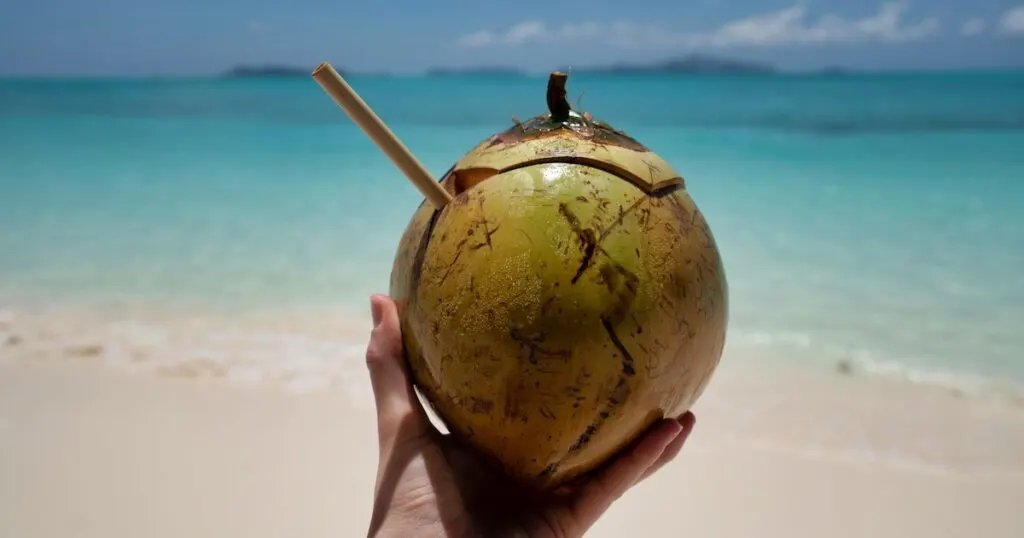
Buko pandan: A cold drink made of green jelly, young coconut, pandan flavouring, milk, and sweetened cream.
Calamansi juice: A citrus drink containing calamansi, sugar and water. This is essentially the Philippines’ version of lemonade.
Iskrambol: Iskrambol is a sweet frozen drink made from shaved ice, condensed milk, milk powder, banana extract, chocolate syrup, and marshmallows. It may be topped with chocolate sprinkles, tapioca pearls, chocolate syrup and strawberry syrup. As long as the toppings are gluten-free, you should be good to go.
Kapeng barako: Kapeng barako is a strong local coffee.
Lambanog: Lambanog is a spirit made from coconut sap with a high alcohol percentage.
Milk tea: Milk tea (and its many flavour variations) are naturally gluten free.
Sago’t gulaman: A drink containing jelly, brown sugar, gulaman (dried agar, which comes from red algae), vanilla, and tapioca pearls.
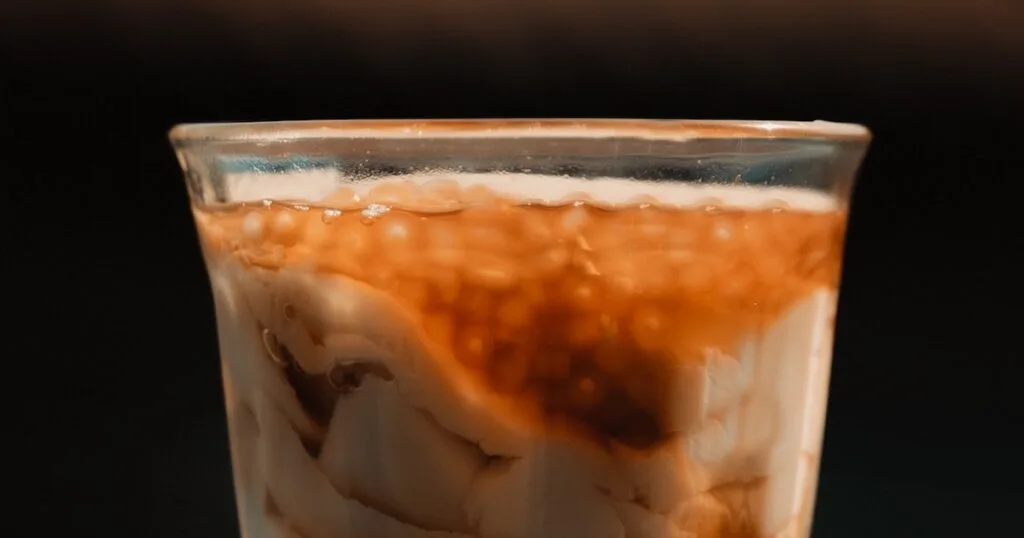
Taho
Taho: Taho is most commonly sold on the street. It consists of silken tofu, sago pearls or tapioca pearls (which are both naturally gluten-free), and brown sugar syrup. These are the only three ingredients, making it a filling gluten-free drink.
Tapuy/tapuey: This alcoholic drink is a fermented rice wine with an alcohol content of roughly 14%.
Sago pearls and tapioca pearls are common in sweet drinks in the Philippines. Both are gluten free. Sago pearls are made from the starch of palm trees and tapioca pearls are made from tapioca starch.
Cross contamination issues in the Philippines
Cross contamination is one of the main hurdles you’ll face if you’re visiting the Philippines with coeliac disease or a wheat allergy.
Part of avoiding cross contamination will be to avoiding deep-fried food, but it’s more than that. The kitchen needs to use different cooking equipment and utensils to handle your food. Therefore, you need to be able to clearly communicate with the restaurant.
Use Google translate liberally. Check the Google reviews of restaurants by searching for keywords like gluten free, coeliac, and wheat allergy. Searching for restaurants where they are fluent in English is also key.
Most restaurants will be happy to show you the kitchen, or at least to introduce you to the chef. Most importantly, if you’re not comfortable, move onto a different restaurant.
The best accommodation if you’re gluten free in the Philippines
Accommodation plays a big role in the ease with which you can find gluten free foods in the Philippines.
With a hotel restaurant that understands your dietary requirements, you always have somewhere you can count on to eat. With your own kitchen, you can cook your own gluten free meals.
1. Hotels
✓ It’s easy to search for hotels with restaurants that have visible menus or a chef who can cater to gluten-intolerant guests.
✓ You can contact a hotel prior to your booking or prior to your arrival to discuss your dietary needs and how they can be catered to.
✖ You may have limited options at hotel restaurants.
✖ There’s always the chance that the restaurant does not fully understand your dietary requirements, or you don’t feel comfortable eating there.
Generally, the bigger and more established the hotel, the more likely it is that they will have an understanding of gluten free food in the Philippines.
You can filter hotels with restaurants on Booking.com or Agoda.
First, let me first recommend a couple of hotels which catered fantastically to my gluten intolerance:
Okura Hotel, Manila
The chef at their restaurant prepared me a seven-course gluten-free meal, which is not an easy feat for a Japanese restaurant. It also has a bridge to the international airport, making it ideal for a brief stay in the city. It’s within walking distance of the mall, where there are further good choices to eat out with a good level of fluency in English. The luxury rooms are Japanese-inspired.
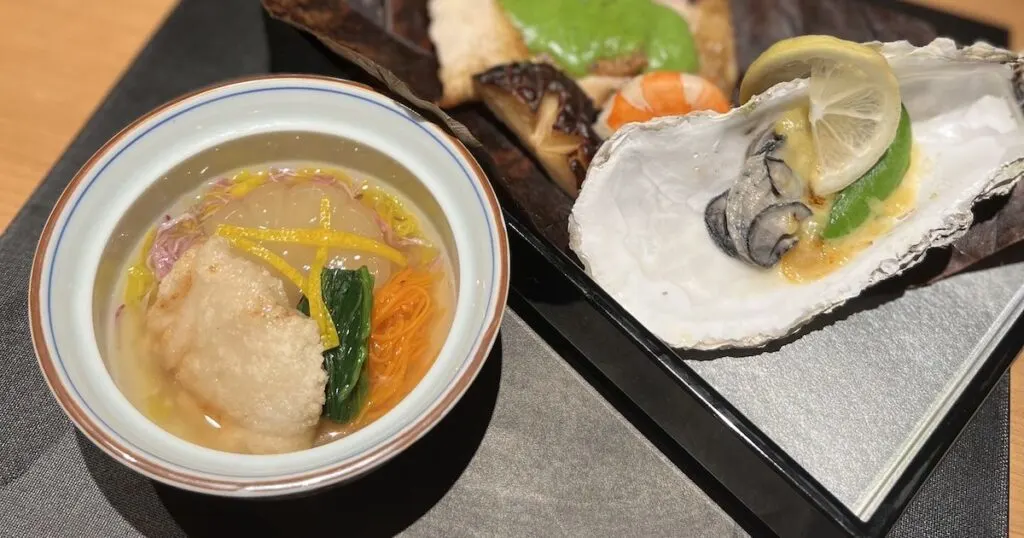
The Farm at San Benito:
One of the only holistic health resorts in the Philippines, The Farm at San Benito is an obvious choice for gluten-intolerant travellers. There’s a doctor on-site who offers a range of treatments, and the resort has a vegetarian, vegan and pescetarian restaurant.
It’s in the perfect spot for fans of offbeat travel, because it is near to Anilao, a diving area; Taal, a heritage town; and Bicol, a beautiful island abundant in gluten-free food due to its use of coconut milk-based rice dishes.
2. Apartments
Staying in an apartment with private kitchen facilities is always a good choice for gluten-intolerant travellers in the Philippines because you can prepare your own meals.
✓ In the cities and towns, there are large supermarkets which sell all of your typical groceries, making it easy to locate the ingredients you need.
✓ Private kitchen facilities mean you don’t have to worry about cross contamination.
✖ Cooking for yourself and gathering ingredients can be time-consuming.
I stayed in an apartment during my week spent working remotely from Puerto Princesa in Palawan, which I found on Booking.com. Make sure that you read the reviews and ensure that the kitchen facilities are private and not shared.
3. Hostels
It’s not typical for hostels in the Philippines to have shared kitchen facilities. However, I did find that many of the hostels in the Philippines have on-site restaurants or cafes serving food, which is useful, because the staff are generally fluent in English and may have met previous gluten-intolerant guests.
✓ Hostels often have on-site restaurants serving food, where staff are fluent in English.
✓ Staff are generally helpful at providing advice around local restaurants which are fluent in English and serve gluten-free meals.
✖ Not all hostels have restaurants, meaning you have to find gluten-free food elsewhere.
4. Homestays
A homestay is an arrangement where you stay with a host family in exchange for a fee. It provides an authentic experience in the home of a local. Meals are often included as part of the homestay.
✓ You may be able to monitor the cooking process and identify cross contamination hazards.
✓ The hosts usually have a good level of English.
✓ Hosts can point you towards helpful restaurants.
✓ You may be able to reach out to a host before travelling to discuss your dietary requirements.
✖ There’s always the chance the host won’t understand you, and you’ll have to look for meals elsewhere.
Gluten free shops in the Philippines
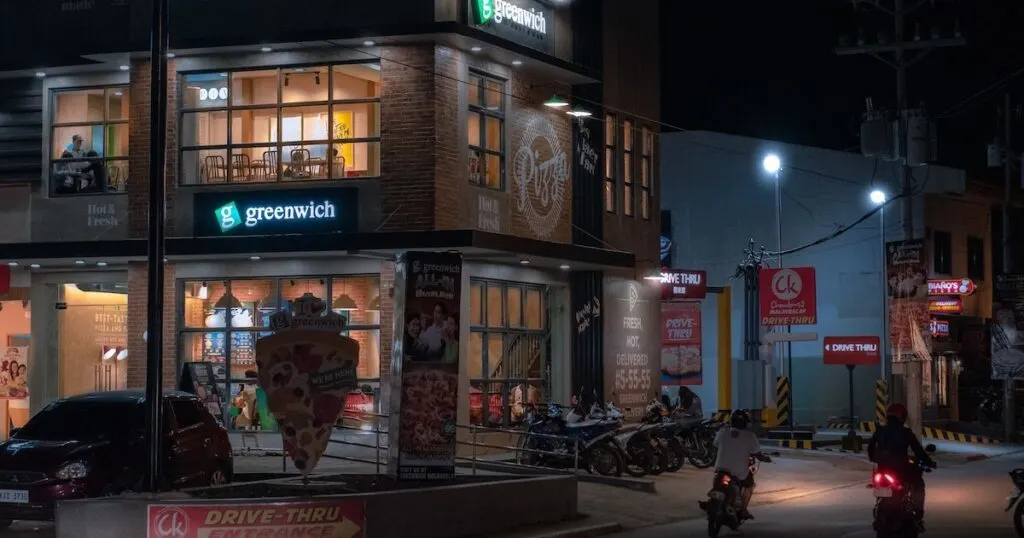
Some gluten-free products can be found in shops in Manila. If you’re an international visitor, it’s likely that you’ll transit through Manila on your way to your next destination in the Philippines. Therefore, you can pick up gluten-free snacks and products for your journey or holiday if you have time.
Saying this, I did find gluten-free biscuits made from corn flour in a shop in Coron, a popular tourist destination. I was delighted about this, and picked up free packets before heading on a three-day island-hopping trip to El Nido with Tao Philippines: for tips on what to wear in Palawan and while island-hopping, see my separate guide.
Healthy Options: This health store chain has a number of branches throughout the Philippines and sells gluten-free staple products.
Marks and Spencers: Marks and Spencers has a range of gluten free products, including gluten-free biscuits and crackers.
Gerald: This shop has a gluten-free section with pasta, bread, and pastry mixes. They also have the Gerald online shop, which delivers gluten-free bread frozen.
Jertie’s Kitchen: They bake gluten-free desserts.
Amores Gluten Free Foods: They bake wheat-free cupcakes, cakes, bread and other pastries.
Gluten free restaurants in Manila
While there are no completely gluten free restaurants in Manila, I can point you towards restaurants in Manila that have been highly-rated in Google Reviews by gluten-free reviewers.
You should check the risk of cross contamination upon arrival.
- Happy Garden Cafe (Makati): The dishes are marked with allergens.
- The Wholesome Table (multiple locations, including Makati and Taguig): Offers labelled gluten-free dishes.
- Corner Tree Cafe (Makati): Gluten-free options are labelled.
- iVegan: Gluten-free options labelled.
- Wildflour Cafe + Bakery: Gluten-free options are available.
Final tips for being gluten free in the Philippines

1. Don’t take ‘yes’ for an answer.
It’s worth repeating: If a Filipino person nods or says ‘yes’ when you ask if your food is gluten-free, and doesn’t actively show their understanding through further discussion, the answer is no. They are nodding and saying yes to please the customer, not because they understand. You need to investigate further, or ask to speak to someone higher up.
2. Some restaurants may confuse ‘glutinous rice’ with gluten.
Aside from sounding pretty similar, gluten has no association with glutinous rice. Glutinous rice is naturally gluten-free. It’s simply a sticky type of rice grown in Asia. You can assure the restaurant that glutinous rice is safe for you to eat.
3. Don’t be afraid to use Google Translate to ask for a special meal.
My go-to breakfast routine after spotting ‘pancakes’ on the menu is to open Google Translate and ask the chef to ‘cook me pancakes without flour by mixing two eggs and one banana’.
The coffee shops and restaurants almost always have eggs and bananas in stock. As long as you cover the risk of cross contamination, you have yourself an easy snack or a small breakfast right there.
4. Focus on what you CAN eat too.
Sometimes restaurants get nervous or overwhelmed. It’s a big deal having to be responsible over whether someone has a reaction to the food, especially when you’re struggling to understand English. Sometimes, it’s also good to focus on what you CAN eat.
You can list off some easy things that you can eat, such as meat and fish, rice, corn, potatoes, eggs, fruit and vegetables, beans, tofu, nuts, oil, salt, sugar, milk, and non-processed cheese (not blue cheese), and spices.
FAQ
Yes. The Philippines has a wide variety of gluten-free food, including rice-based dishes, rice cakes, and snacks. Gluten-free travellers should avoid wheat-containing pancit (noodle) dishes, soy sauce, fish sauce, oyster sauce, deep-fried food and wheat-containing bread or pastries, among other things.
Yes. Gluten-free Filipino food choices include Bicol Express, champorado, laing, puchero, biko, and halo-halo. Many Filipino meals are not gluten free because they are seasoned with soy sauce, oyster sauce, or fish sauce, so these should be omitted or substituted.
Sotanghon noodles are translucent glass noodles, made out of mung bean (monggo) starch. They are gluten free.


Friday 29th of November 2024
Thank you! Badly need this. God bless.
a
Tuesday 2nd of July 2024
Fantastic webpage, thank you.
TravelNerd
Monday 16th of October 2023
Many thanks 🙏